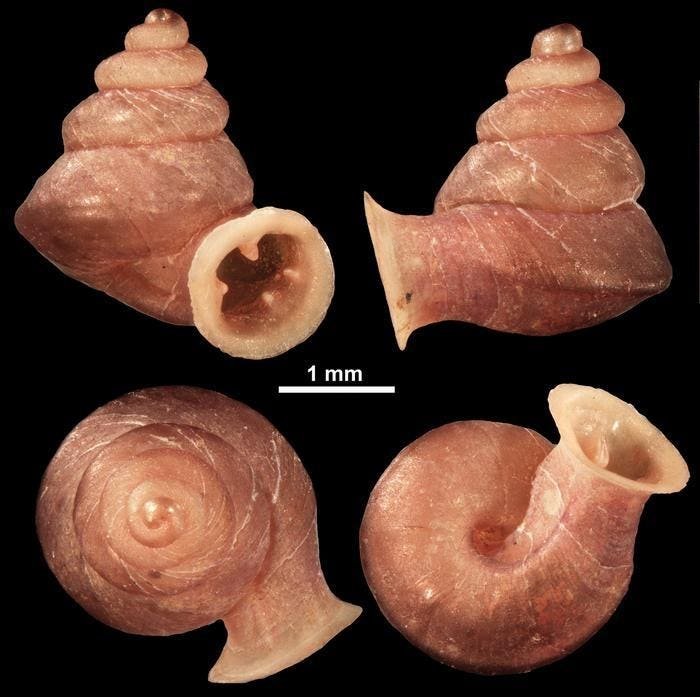A tiny snail was recently named after painter Pablo Picasso. It’s one of many species named after celebrities or artists, but some researchers question whether species should be named after people at all.
A tiny snail was named Anauchen picasso, after the blocky whorls on the shell reminded researchers … More
How do you name a snail? That’s a question that several mollusk researchers tried to answer when they re-evaluated the names of hundreds of snail species from Southeast Asia. They sifted through a large museum collection to find out whether the way that these snails had been classified and named in the past still made sense.
Like other species, snails are given a Latin name based on their taxonomical classification. At the top level of this taxonomy, all species are grouped into either one of the domains of bacteria, archae or eukarya. The first two domains are microbial, but the eukarya include all animals, plants, fungi and a few other organisms. Humans and snails are both in the kingdom of animals, but after that we quickly diverge into separate branches of the taxonomical tree. We’re in the phylum of vertebrates, like other animals with internal skeletons, but snails are mollusks. After domain, kingdom and phylum, the next taxonomy subcategories are class, order, family, genus and species.
Those last two levels, genus and species, also form the official name of every unique type of organism. These dual names are used for anything that lives or used to live. Humans are Homo sapiens, Monstera deliciosa is a trendy house plant, Tyrannosaurus rex was a big dinosaur, Escherichia coli (or E. coli for short) is a type of bacteria, and now there is a very tiny snail from Thailand called Anauchen picasso.
Inspired names for new organisms
Any biologist who first discovers a new species (or occasionally an entirely new genus) can come up with a name for it. There are rules about capitalisation, italics and standard abbreviations, but beyond that, anything goes. Some species are named after that organism’s defining properties. For example, “sapiens” means “knowing”, because humans can be pretty smart sometimes. Other species are named after the location where they’re found, like the mosquito Aedes aegypti, named after Egypt. Many researchers also use the opportunity to name a species after a famous person.
The name Anauchen picasso was inspired by the boxy patterns in the snail’s shell. Instead of smooth spirals, it had unexpected angles like a Picasso painting. In a similar vein, other researchers named a wasp Nanochtulhu lovecrafti because its head kind of reminded them of a small version of H.P. Lovecraft’s character Chtulhu.
Many other species are named after famous artists as well. Say “spiders” and your mind might wander to “spiders from Mars”, so the Heteropoda davidbowie spider, the Spintharus davidbowiei spider and an entire genus of Bowie spiders are all named after David Bowie, who also has a trilobite, slug and fly named after him. Likewise, there are multiple beetles named after The Beatles as a group or after their individual members, and a fossil species of water lilies is named after Claude Monet, famous for his water lily paintings.
Sometimes, biologists just like to name their newly discovered species after people they admire. Kate Winslet, Shakira, Greta Thunberg, Gandhi, Douglas Adams, Johnny Cash and many other famous people all have species named after them.
Should new species be named after people?
In 2023, an international group of researchers argued that these tribute names can be a problem. The problem isn’t so much with naming a beetle after The Beatles, but with the history of some of the names. Although there are still new species being discovered today, huge numbers of them were discovered and named in the past, when biology wasn’t yet as inclusive as it is today. As the researchers in the 2023 commentary noted, “9th-century and early 20th-century taxonomy was largely dominated by white men who, by and large, honoured other men (funders, colleagues, collectors and so on) of their own nationality, ethnicity, race and social status.”
So even though most species are not found in Europe, many of them are named after Europeans. At best, it doesn’t make much sense. But it can get much, much worse. In 1933, scientists named a newly discovered beetle after Hitler. That certainly didn’t age well, but the name cannot be changed. Even though there is a lot of freedom about choosing new names for species, there are very strict rules about renaming them, and the beetle Anophthalmus hitleri did not meet those criteria. But it gets even worse. As a result of its name, the beetle has become a collector’s item to people who collect Nazi memorabilia, so it’s now a threatened species. Even that doesn’t meet the rules for renaming, though.
The authors of the commentary about the naming issue argue that to avoid things like this, no species should be named after a person at all. They wrote, “we believe that naming species in honour of real people is unnecessary and objectively difficult to justify. The Earth’s biodiversity is part of a global heritage that should not be trivialized by association with any single human individual, whatever their perceived worth.”
Maybe the rules will change one day, but until that happens, there will still be plenty of new species named after artists and other famous people. Even though a Thai snail called Picasso doesn’t make much sense, it’s still a chance to grab some attention and get people to think about snails and biodiversity.





